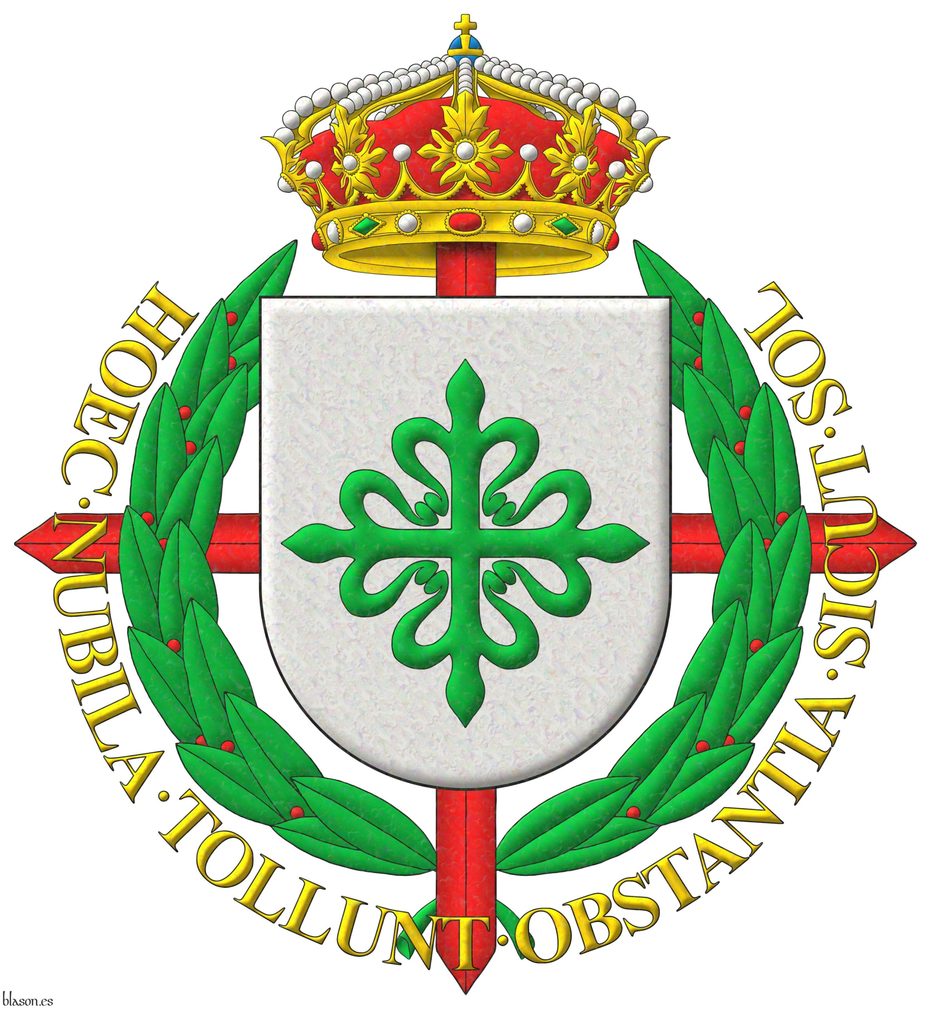
Order of Calatrava, emblem
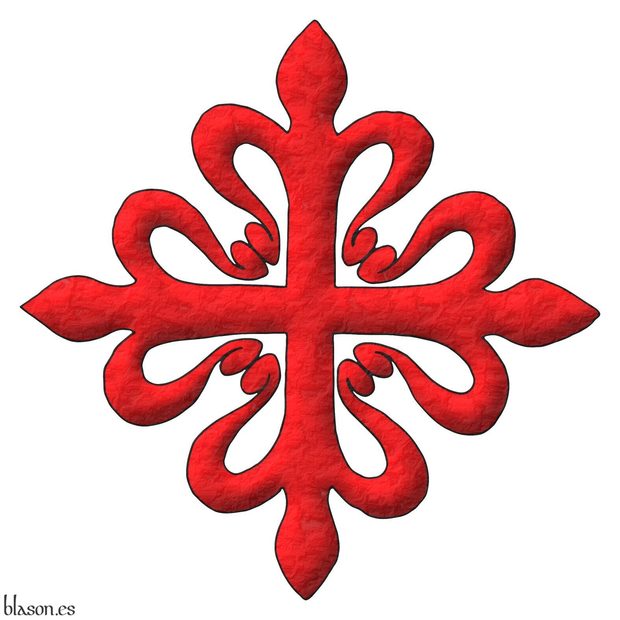
Order of Chivalry of Calatrava
A cross of Calatrava.
Una cruz de Calatrava.
Interpretation of the emblem of the order with: its cross outlined in Sable, illuminated in Gules; and a heavily beaten metal finish.
The Royal Council of the Orders of Chivalry of Santiago, Calatrava, Alcantara, and Montesa, in its historical review of the foundation of the Order of Calatrava, states that it was founded during the reign of Sancho III of Castile in the 12th century.
After the Templars withdrew from the defense of the town, King Sancho III proposed in Toledo and later confirmed in Almazán, in January 1158, the perpetual donation of the town of Calatrava to Raymond, then Abbot of the Cistercian monastery of Fitero, who, together with the former soldier Diego Velázquez, committed to defending it from attacks by the Almohads. For this mission, they received financial support from the Archbishop of Toledo, Juan, and from Toledo itself, thus managing to form an army of more than 20,000 men.
Emblem
Regarding the emblem of the Order of Chivalry of Calatrava [Avilés, J.; 1780b; treatise IV, chapter IV, page 338, figure 102] it states «the Seal was always a red cross with blue straps, and the Banner originally bore a black Cross; but today they use the red cross florety, bordered with eight circles, placed side by side, and joined at the center, formed by a cord that emerges from the leaves of the flower, which Benedict XIII gave (while recognized in Spain) and which is the Commandery that the Knights of this Order wear on their chest today, or hanging from a red ribbon on a gold medal; that is, on a field of Or a cross of Gules».
Blazon keywords: Cross of Calatrava, Cross couped and Cross.
Style keywords: Illuminated, Outlined in sable and Soft metal.
Classification: Interpreted, Religious, Military and Emblem.
Bearer: Calatrava, Order of.


Jamilena
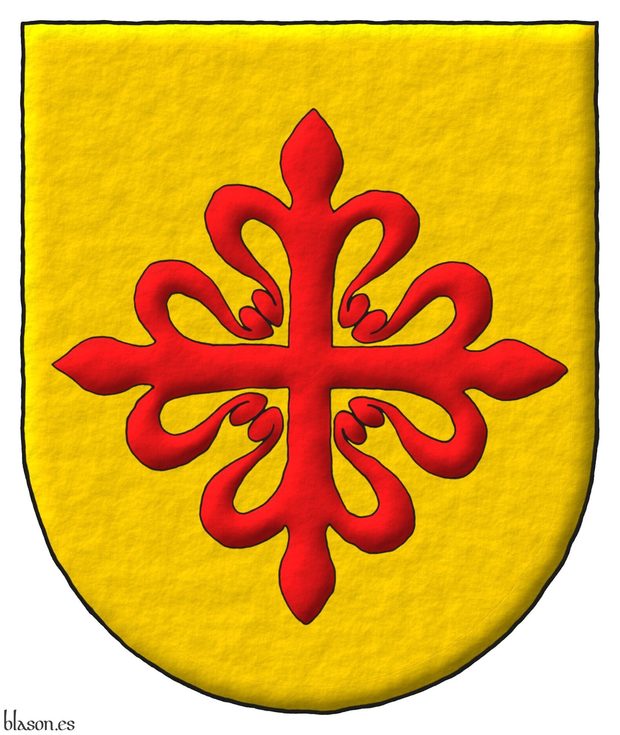
Coat of arms of the municipality of Jamilena, province of Jaén.
Or, a cross of Calatrava.
Escudo de oro, una cruz de Calatrava.
Coat of arms interpreted as follows: the shield's shape is a semicircular arch; the field is illuminated in metal Or; the cross of Calatrava is outlined in Sable and illuminated in Gules; and the entire piece has a rough line finish.
Blazon keywords: Without divisions, Or, Cross of Calatrava, Cross couped and Cross.
Style keywords: Semi-circular, Illuminated, Outlined in sable and Freehand.
Classification: Interpreted, Civic and Coat of arms.
Bearer: Jamilena.


Jamilena, province of Jaen
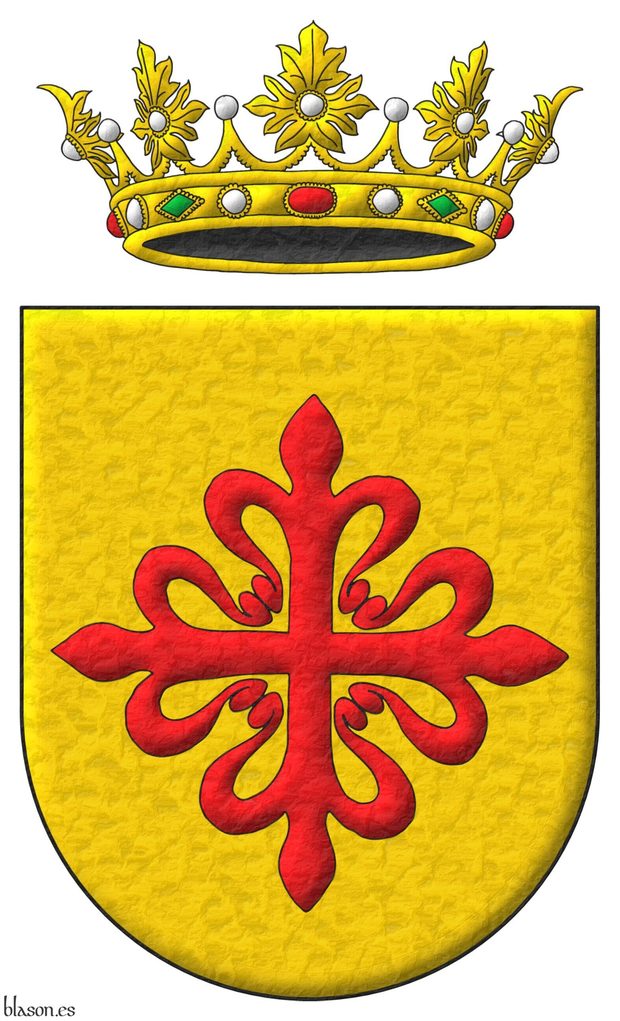
Or, a cross of Calatrava. Crest: An open royal crown Or.
Escudo de oro, una cruz de Calatrava. Timbrado de una corona real abierta.
Coat of arms interpreted as follows: the shield's shape is a semicircular arch; the field is illuminated in metal Or; the cross of Calatrava is outlined in Sable and illuminated in Gules; the royal crown is open, outlined in Sable and illuminated in metal Or, pearls in Argent, gemstones in Gules and Vert, and the visible base hollow in Sable; and the entire piece has a slightly hammered metal finish.
The municipality of Jamilena belongs to the La Campiña region and is the smallest in the province of Jaén. I have depicted its coat of arms with an open royal crown, but representations with a closed royal crown can also be found.
The origin of the cross of Calatrava in its heraldic coat of arms dates back to the year 1525 when Emperor Charles V issued several decrees from Toledo to build a convent for nuns in Jamilena. For the construction of this convent, stones from the Muslim castle, which was reformed and occupied by the Order of Calatrava, were used.
Blazon keywords: Without divisions, Or, Cross of Calatrava, Cross couped, Cross, Crest, Open royal crown and Crown.
Style keywords: Semi-circular, Illuminated, Outlined in sable and Soft metal.
Classification: Interpreted, Civic and Coat of arms.
Bearer: Jamilena.


![Ver [Alcantara, Order of] en instituciones citadas. Fortaleza de oro y mazonada de sable.](../css/Fortaleza.Institucion.png)
Alcantara, Order of
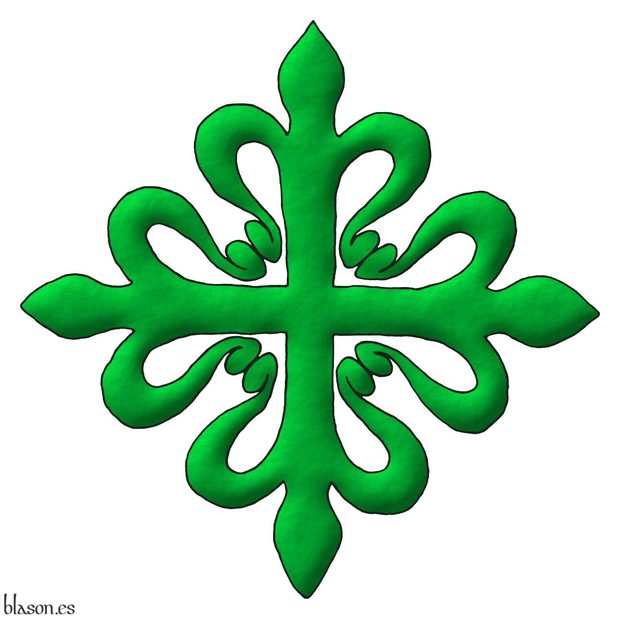
It was founded by Count Henry of Burgundy as a military and religious order, in the year 1093, in Beira Alta, Portugal, near the river Côa with the initial name of «Ordem de São Julião do Pereiro» ~ Order of Saint Julian of Pereiro.
In the year 1214, the defense of the city of Alcantara after its conquest was entrusted to the Order of Calatrava, but in 1218 the Calatravans relinquished it due to Alcantara being far from Calatrava.
To defend Alcantara, King Alfonso IX of León entrusted it to the new Order of the Knights of Saint Julian of Pereiro, requesting in return a certain level of dependency on the Order of Calatrava, which led the Knights of Saint Julian to adopt the Cistercian rule.
Once established in Alcantara, their original name referring to Saint Julian fell into disuse, and by 1253 there were already references to the «masters of the Order of Alcantara», with Saint Julian of Pereiro becoming the foundational center and a secondary commandery of the order.
On the origin and antiquity of the Military Order of Alcantara, and the form of its Commandery
[Avilés, J.; 1780b; treatise IV, chapter V, page 339] describes it as follows: «The Military Order, which we now call of Alcantara, was formerly that of Saint Julian of Pereiro, so named after the place where it was based, along the banks of the river Côa, in the Bishopric of Ciudad-Rodrigo, established in the year 1176 by King Ferdinand II of León, and confirmed in 1177 by Pope Alexander III. And the reason for changing its first name to the second, was because after the Knights of Calatrava had taken the City of Alcantara from the Moors and defended it bravely thereafter, they found it would be difficult to keep it, as their main house was very distant, from which the other Knights and reinforcements could not come whenever needed.».
[Avilés, J.; 1780b; treatise IV, chapter V, page 340] continues by telling us «They discussed this inconvenience with others they had at the time with the King of León, Don Alfonso IX, and it was resolved that the Master of Calatrava would give that town to the Knights of Pereiro so that they might defend it, as they did, under certain conditions in the year 1218, later performing marvels in its defense, earning through their fame and distinguished feats new graces from the Kings; and seeing how essential their residence was, the Knights of Pereiro moved to the town of Alcantara, establishing their Convent there, and thus transformed into Knights of Alcantara, who were previously Knights of Saint Julian of Pereiro».
Categories: Institution, Interpreted, Religious, Military, Illuminated, Outlined in sable, Freehand, Emblem, Cross of Alcantara, Cross couped and Cross.


Order of Alcantara, emblem
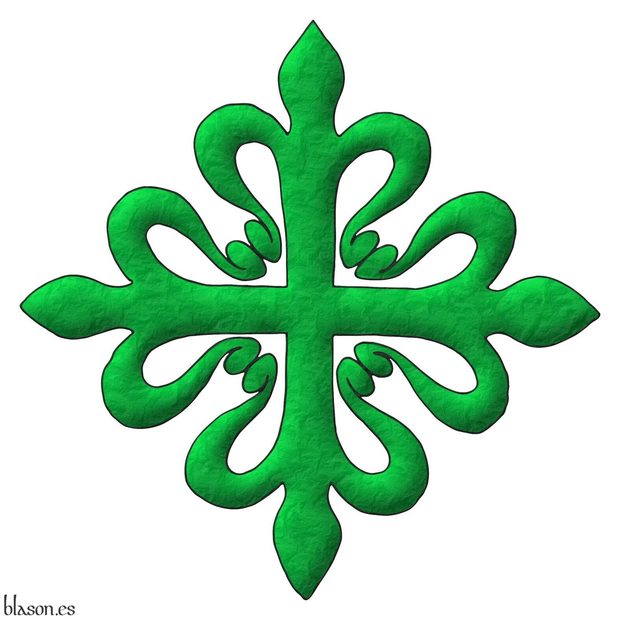
Order of Cavalry of Alcantara
A cross of Alcantara.
Una cruz de Alcántara.
Interpretation of the emblem of the order with: its cross outlined in Sable, illuminated in Vert; and a heavily beaten metal finish.
The Royal Council of the Orders of Chivalry of Santiago, Calatrava, Alcantara, and Montesa, in its historical account of the foundation of the Order of Alcantara, states that, according to Alonso de Torres y Tapia, Prior of Alcantara and a 17th-century chronicler, it was founded in 1156, by Don Suero Fernández Barrientos along with other knights from Salamanca, in Pereiro near the River Coa, under the name of the Order of Saint Julian of Pereiro and during the reign of Ferdinand II of León.
Emblem
Regarding the emblem of the Order of Cavalry of Alcantara, [Avilés, J.; 1780b; treatise IV, chapter V, page 340, figure 102], reusing the same figure 102 as for the Order of Calatrava, says «In the past, the Order of Alcantara displayed on its Standard the Gules Straps of Calatrava», remember that due to the commandery of the city of Alcantara, they had to assume some dependency on that of Calatrava, «next to a Pear tree in Vert on a field of Or, which was the insignia of the Order of Pereiro, due to the conformity with which these two Orders lived; but upon changing their Habit, the Pope» Eugene IV «granted them the green Cross», Vert, «in the manner they wear it today, differing from that of Calatrava only in color».
Blazon keywords: Cross of Alcantara, Cross couped and Cross.
Style keywords: Illuminated, Outlined in sable and Soft metal.
Classification: Interpreted, Religious, Military and Emblem.
Bearer: Alcantara, Order of.


Alcantara, Cavalry Regiment
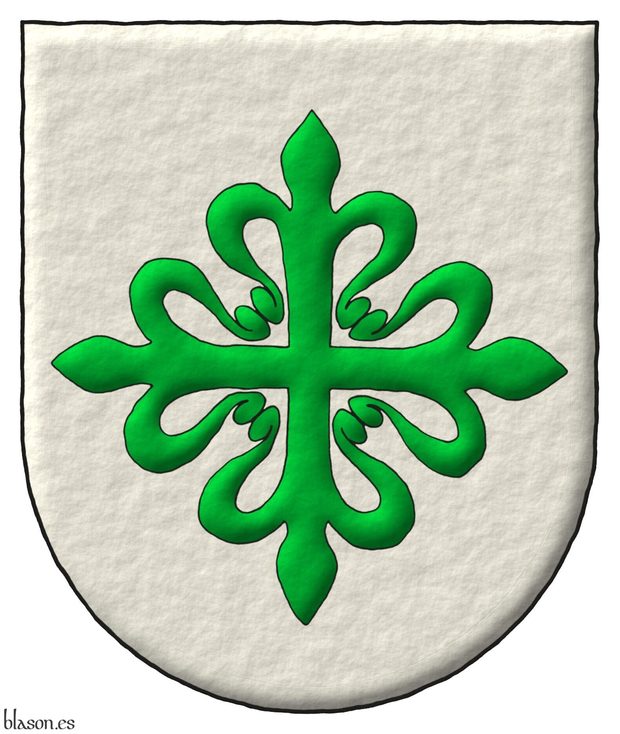
Coat of arms of the Armored Cavalry Regiment Alcantara No. 10, RCAC-10, in 2016.
Argent, a cross of Alcantara.
Escudo de plata, una cruz de Alcántara.
Coat of arms interpreted in the following manner: the shape of the shield is of a semicircular arch; the field is illuminated in the metal Argent; the cross of Alcantara is outlined in Sable and illuminated in Vert; and the whole has a raised stroke finish.
Blazon keywords: Without divisions, Argent, Cross of Alcantara, Cross couped and Cross.
Style keywords: Semi-circular, Illuminated, Outlined in sable and Freehand.
Classification: Interpreted, Military, Army and Navy and Coat of arms.
Bearer: Alcantara, Cavalry Regiment.


Cavalry Regiment Alcantara, royal crown
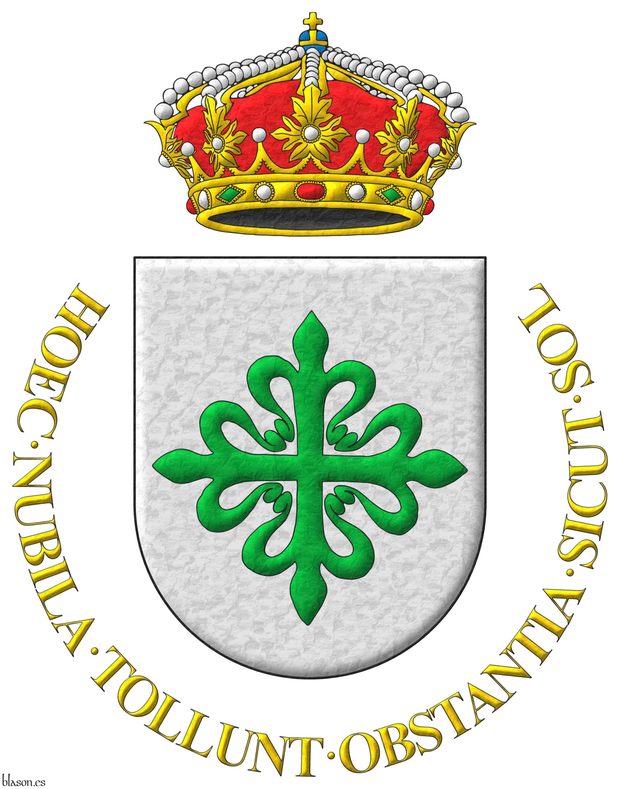
Disperse like the sun clears the clouds in your path.
Argent, a cross of Alcantara. Crest: A closed royal crown Or, with eight arches, visible five. Motto: «Hoec nubila tollunt obstantia sicut sol».
Escudo de plata, una cruz de Alcántara. Timbrado de una corona real cerrada. Lema: «Hoec nubila tollunt obstantia sicut sol».
Coat of arms interpreted in the following manner: the shape of the shield is of a semicircular arch; the field is illuminated in metal Argent; the cross of Alcantara is outlined in Sable and illuminated in Vert; the royal crown is closed, outlined in Sable and illuminated with the metal Or, Argent for the pearls, Azure and Or for the orb, Gules and Vert for the gems, Gules for the inner cloth, and Sable for the visible hollow at its base; and the whole has a slightly hammered metal finish.
Regiment's Motto
The Latin motto «Hoec nubila tollunt obstantia sicut sol» is often translated as «Ride like the sun, disperses the clouds in its path». I would like to offer the following observations on this translation:
- Instead of «disperse», I prefer the verb «scatter» which is more aligned with a cavalry regiment, [Royal Spanish Academy; 2001] «scatter, 3rd meaning, transitive verb, military term: To break up, rout the enemy, causing them to flee and scatter in complete disorder».
- On the other hand, even though it is about cavalry, I do not find that the Latin motto makes reference to riding, a verb that is also not needed to understand the motto's meaning, and adding an extra word lengthens the motto, reducing its impact.
- Finally, I use «your», instead of «its», so that the motto is a direct and personal rallying cry and not a phrase directed at a third person.
Blazon keywords: Without divisions, Argent, Cross of Alcantara, Cross couped, Cross, Crest, Closed royal crown, Crown and Motto.
Style keywords: Semi-circular, Illuminated, Outlined in sable and Soft metal.
Classification: Interpreted, Military, Army and Navy and Coat of arms.
Bearer: Alcantara, Cavalry Regiment.


Cavalry Regiment Alcantara, Laureate of Saint Ferdinand
Grand Laureate Cross of Saint Ferdinand.
Argent, a cross of Alcantara. Crest: A closed royal crown Or, with eight arches, visible five. Behind the shield the Laureate Grand Cross of Saint Ferdinand. Motto: «Hoec nubila tollunt obstantia sicut sol».
Escudo de plata, una cruz de Alcántara. Timbrado de una corona real cerrada. Acolada detrás del escudo la gran cruz laureada de San Fernando. Lema: «Hoec nubila tollunt obstantia sicut sol».
Coat of arms interpreted in the following manner: the shape of the shield is of a semicircular arch; the field is illuminated in metal Argent; the cross of Alcantara, the 4 swords and the 2 laurel branches are outlined in Sable and illuminated in Vert and Gules; the royal crown is closed, outlined in Sable and illuminated with the metal Or, Argent for the pearls, Azure and Or for the orb, Gules and Vert for the gems, Gules for the inner cloth, and Sable for the visible hollow at its base; and the whole has a iridescent finish.
Rif War, July 23, 1921, banks of the Igan River, North Africa
The Alcantara Regiment executed nine successive cavalry charges to protect the infantry's retreat, nine charges until they broke the enemy lines, outnumbering them. The last charge was on foot because all their horses were dead or exhausted. These heroic riders of Alcantara had fulfilled their duty of protecting the wounded infantry in their retreat to El Batel, but the price was appalling: of 691 riders, only 67 survived, and three months were necessary to recover hundreds of corpses.
For this reason, in 2012, the Alcántara Regiment was collectively awarded the Grand Laureate Cross of Saint Ferdinand.
Two lances behind the shield
Since 1987, the coat of arms of the cavalry regiments of the Spanish Army must carry two crossed lances accolade behind the shield. And indeed, this coat of arms of the Alcántara Cavalry Regiment has two lances behind the shield, but in my artistic heraldic interpretation, I did not paint them to avoid detracting from the prominence of the Laureate Cross.
Blazon keywords: Without divisions, Argent, Cross of Alcantara, Cross couped, Cross, Crest, Closed royal crown, Crown, Behind the shield, Four, Sword, Crosswise, Gules, Two, Branch, Laurel, Vert and Motto.
Style keywords: Semi-circular, Illuminated, Outlined in sable and Iridescent.
Classification: Interpreted, Military, Army and Navy and Coat of arms.
Bearer: Alcantara, Cavalry Regiment.

Continue with: Montesa, Order of.
-
Language
-
Categories of heraldry
-
Divisions of the field
- Without divisions
- Party per pale
- Party per fess
- Party per bend
- Party per bend sinister
- Tierce
- Tierce sinister
- Tierced per pale
- Tierced per fess
- Tierced per bend
- Tierced pallwise inverted
- Quarterly
- Quarterly per saltire
- Gyronny
- Party per fess, the chief per pale
- Party per pale, the sinister per fess
- Party per fess, the base per pale
- Party per pale, the dexter per fess
- Chapé
- Chaussé
- Embrassé
- Contre-embrassé
- Party per chevron
- Enté
- Enté en point
- Flanched
-
Metals
-
Colours
-
Furs
-
Other tinctures
-
Ordinaries and sub-ordinaries
-
Diminutives of the ordinaries
-
Geometric charges
-
Composite ordinaries
-
Inanimate charges from Nature
Atom, Crescent, Diamond, Emerald, Estoile, Increscent, Lightning flash, Moon, Mount, Mullet, Mullet of four points, Orbital, Plough of Ursa Major, Rainbow, Ray of the sun, River, Sea, Snowflake, Sun, Sun in splendour, Sun of May, Trimount, Water and Wave.
-
Vegetal charges from Nature
Acorn, Apple, Apple tree, Ash, Bluebonnet, Camellia, Chrysanthemum, Cinquefoil, Cornflower, Dogwood flower, Double rose, Elm, Fleur de lis, Flower, Gourd, Holm oak, Hop cone, Kapok tree, Laurel, Lily, Linden, Lotus flower, Madonna lily, Mexican cedar tree, Oak, Olive tree, Palm tree, Plantain plant, Pomegranate, Poplar leaf, Rose, Shamrock, Sunflower, Thistle, Tree, Tulip, Vine and Wheat.
-
Animal charges from Nature
Badger, Bald eagle, Barbel, Barn owl, Bear, Beaver, Beetle, Bighorn sheep, Blackbird, Boar, Brach hound, Bull, Doe, Dog, Dolphin, Dove, Eagle, Elephant, Falcon, Female figure, Fish, Flame, Fly, Fox, Frog, Goat, Goldfinch, Goose, Heron, Horse, Hummingbird, Jaguar, Lark, Leopard, Lion, Lion passant, Lion rampant guardant, Lioness, Lynx, Male figure, Martlet, Merino ram, Owl, Panther, Parrot, Peacock, Pelican, Pelican in her piety, Puffin, Quetzal, Raven, Roe deer, Rooster, Savage, Seagull, Serpent, She-wolf, Stag, Starling, Talbot, Tyger, Vulture, Warren hound and Wolf.
-
Parts of natural charges
Arm, Beak, Branch, Caboshed, Chest, Claw, Covert, Dorsal fin, Eagle claw, Ermine spot, Escallop, Feather, Foot (palmiped), Foreleg, Forepaw, Hand, Head, Heart, Hoof, Leaf, Neck, Ostrich feather, Palm frond, Paw, Roe deers' attires, Shoulder, Sprig, Stags' attires, Stem, Swallow-tail, Tail, Tail addorsed, Tail fin, Talon, Tibia, Tooth, Trunk, Trunk (elephant), Two hands clasped, Two wings in vol, Udder, Wheat spike, Wing and Wrist.
-
Artificial charges
Ace of spades, Anchor, Anvil, Arch, Arm vambraced, Armillary sphere, Arrow, Axe, Bell, Bell tower, Beret, Bonfire, Book, Bookmark, Bow, Branding iron, Bridge, Broken, Buckle, Cannon, Cannon dismounted, Cannon port, Canopy roof, Carbuncle, Castle, Celtic Trinity knot, Chain, Chess rooks, Church, Clarion, Clay pot, Closed book, Club, Column, Comb, Compass rose, Conductor's baton, Cord, Covered cup, Crozier, Crucible, Cuffed, Cup, Cyclamor, Dagger, Double vajra, Drum, Ecclesiastical cap, Fanon, Federschwert, Fleam, Four crescents joined millsailwise, Galician granary, Garb, Gauntlet, Geometric solid, Grenade, Halberd, Hammer, Harp, Host, Hourglass, Key, Key ward, Knight, Knot, Lantern, Letter, Line, Loincloth, Menorah, Millrind, Millstone, Millwheel, Monstrance, Mortar, Mullet of six points pierced, Nail, Non-classic artifact, Norman ship, Number, Oar, Oil lamp, Open book, Page, Pair of scales, Parchment, Pestle, Piano, Pilgrim's staff, Plough share, Polish winged hussar, Port, Portcullis, Potent, Quill, Ribbon, Rosette of acanthus leaves, Sabre, Sackbut, Sail, Scroll, Scythe, Sheaf of tobacco, Ship, Skirt, Spear, Spear's head, Stairway, Star of David, Step, Sword, Symbol, Tetrahedron, Torch, Tower, Trident, Trumpet, Turret, Two-handed sword, Wagon-wheel, Water-bouget, Wheel, Winnowing fan and With a turret.
-
Immaterial charges
Angel, Archangel, Basilisk, Dragon, Dragon's head, Garuda, Golden fleece, Griffin, Heart enflamed, Justice, Mermaid, Our Lady of Mercy, Ouroboros, Paschal lamb, Pegasus, Phoenix, Sacred Heart of Jesus, Saint George, Sea-griffin, Trinity, Triton, Unicorn, Winged hand and Wyvern.
-
External elements
-
Heraldic creations
-
References
-
Formats
-
Keywords on this page
Behind the shield, Alcantara, Cavalry Regiment, Alcantara, Order of, Calatrava, Order of, Crest, Crown, Open royal crown, Closed royal crown, Cross, Cross of Alcantara, Cross of Calatrava, Cross of Montesa, Cross couped, Four, Outlined in sable, Two, Army and Navy, Emblem, Coat of arms, Sword, Gules, Illuminated, Institution, Interpreted, Iridescent, Jamilena, Laurel, Motto, Semi-circular, Soft metal, Military, Montesa, Order of, Or, Argent, Without divisions, Civic, Crosswise, Branch, Religious, Vert and Freehand.

